A Comparative Literature Review: Good Country People and The Birthmark
VerifiedAdded on 2020/03/28
|9
|1923
|248
Literature Review
AI Summary
This literature review provides a comparative analysis of Flannery O'Connor's 'Good Country People' and Nathaniel Hawthorne's 'The Birthmark', exploring their shared thesis that humanity possesses inherent flaws, both internal and external. The review delves into the authors' distinct approaches, with Hawthorne emphasizing external imperfections and O'Connor incorporating both physical and character flaws. It examines the influence of historical contexts, including the Enlightenment for Hawthorne and mid-20th-century social dynamics for O'Connor. The analysis covers point of view, tone, and characterization, highlighting how the stories portray flaws and societal acceptance. Key themes such as acceptance, identity, religion, and education are examined, along with the use of figures of speech like irony and imagery. The review concludes by emphasizing the exploration of human nature and the quest for perfection in both stories, offering insights into female gender stereotypes, discrimination, and individualized ideals.
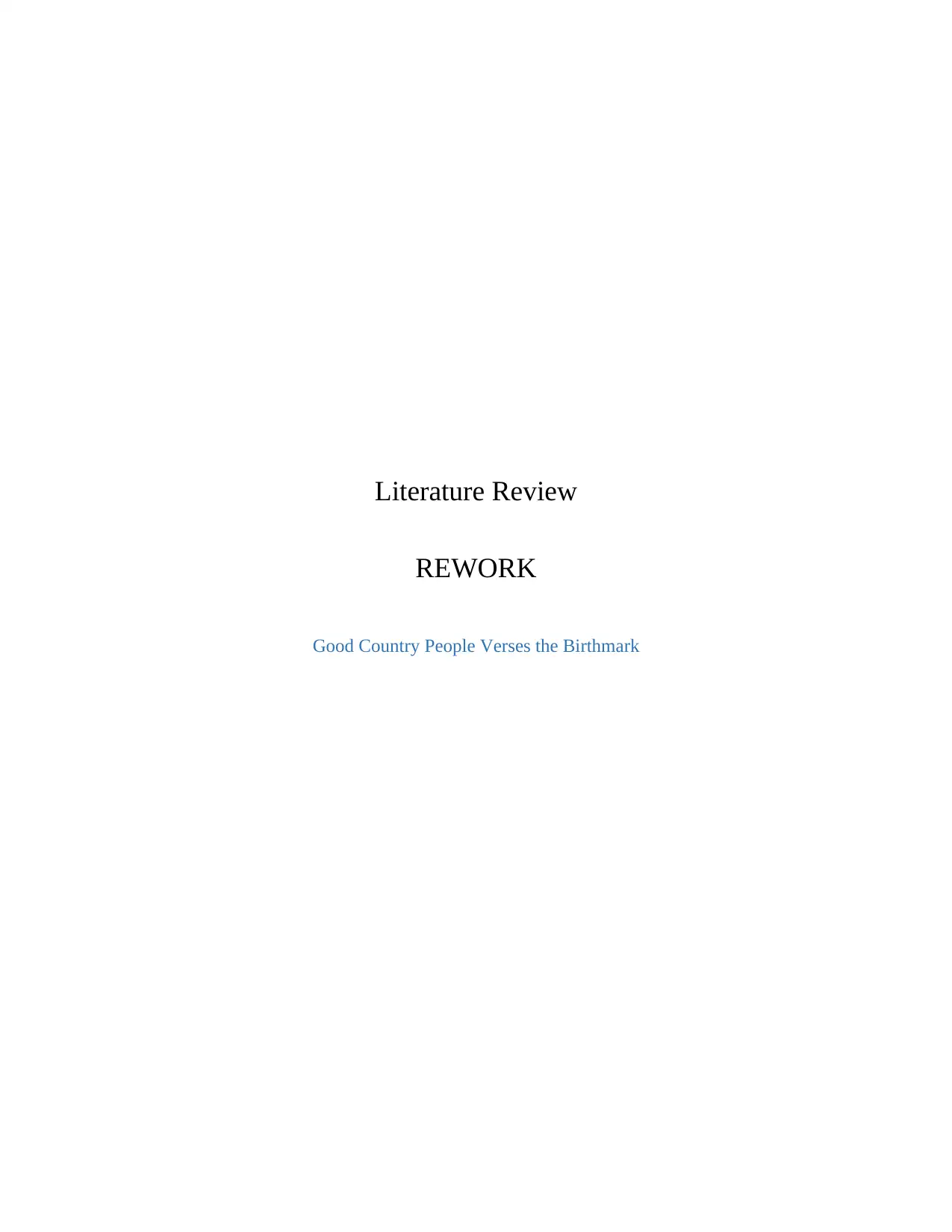
Literature Review
REWORK
Good Country People Verses the Birthmark
REWORK
Good Country People Verses the Birthmark
Paraphrase This Document
Need a fresh take? Get an instant paraphrase of this document with our AI Paraphraser

Kindly attach rework form as page 1
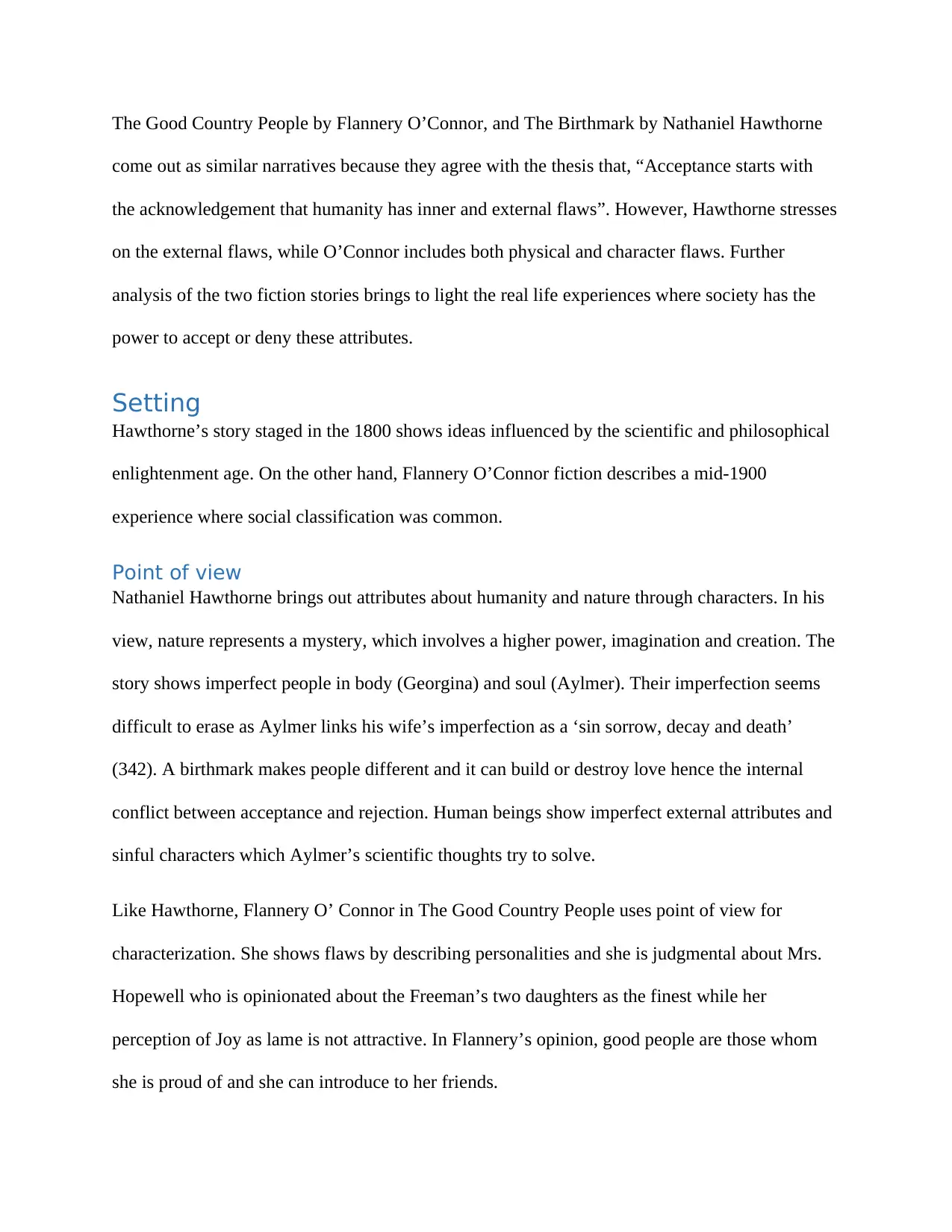
The Good Country People by Flannery O’Connor, and The Birthmark by Nathaniel Hawthorne
come out as similar narratives because they agree with the thesis that, “Acceptance starts with
the acknowledgement that humanity has inner and external flaws”. However, Hawthorne stresses
on the external flaws, while O’Connor includes both physical and character flaws. Further
analysis of the two fiction stories brings to light the real life experiences where society has the
power to accept or deny these attributes.
Setting
Hawthorne’s story staged in the 1800 shows ideas influenced by the scientific and philosophical
enlightenment age. On the other hand, Flannery O’Connor fiction describes a mid-1900
experience where social classification was common.
Point of view
Nathaniel Hawthorne brings out attributes about humanity and nature through characters. In his
view, nature represents a mystery, which involves a higher power, imagination and creation. The
story shows imperfect people in body (Georgina) and soul (Aylmer). Their imperfection seems
difficult to erase as Aylmer links his wife’s imperfection as a ‘sin sorrow, decay and death’
(342). A birthmark makes people different and it can build or destroy love hence the internal
conflict between acceptance and rejection. Human beings show imperfect external attributes and
sinful characters which Aylmer’s scientific thoughts try to solve.
Like Hawthorne, Flannery O’ Connor in The Good Country People uses point of view for
characterization. She shows flaws by describing personalities and she is judgmental about Mrs.
Hopewell who is opinionated about the Freeman’s two daughters as the finest while her
perception of Joy as lame is not attractive. In Flannery’s opinion, good people are those whom
she is proud of and she can introduce to her friends.
come out as similar narratives because they agree with the thesis that, “Acceptance starts with
the acknowledgement that humanity has inner and external flaws”. However, Hawthorne stresses
on the external flaws, while O’Connor includes both physical and character flaws. Further
analysis of the two fiction stories brings to light the real life experiences where society has the
power to accept or deny these attributes.
Setting
Hawthorne’s story staged in the 1800 shows ideas influenced by the scientific and philosophical
enlightenment age. On the other hand, Flannery O’Connor fiction describes a mid-1900
experience where social classification was common.
Point of view
Nathaniel Hawthorne brings out attributes about humanity and nature through characters. In his
view, nature represents a mystery, which involves a higher power, imagination and creation. The
story shows imperfect people in body (Georgina) and soul (Aylmer). Their imperfection seems
difficult to erase as Aylmer links his wife’s imperfection as a ‘sin sorrow, decay and death’
(342). A birthmark makes people different and it can build or destroy love hence the internal
conflict between acceptance and rejection. Human beings show imperfect external attributes and
sinful characters which Aylmer’s scientific thoughts try to solve.
Like Hawthorne, Flannery O’ Connor in The Good Country People uses point of view for
characterization. She shows flaws by describing personalities and she is judgmental about Mrs.
Hopewell who is opinionated about the Freeman’s two daughters as the finest while her
perception of Joy as lame is not attractive. In Flannery’s opinion, good people are those whom
she is proud of and she can introduce to her friends.
⊘ This is a preview!⊘
Do you want full access?
Subscribe today to unlock all pages.

Trusted by 1+ million students worldwide
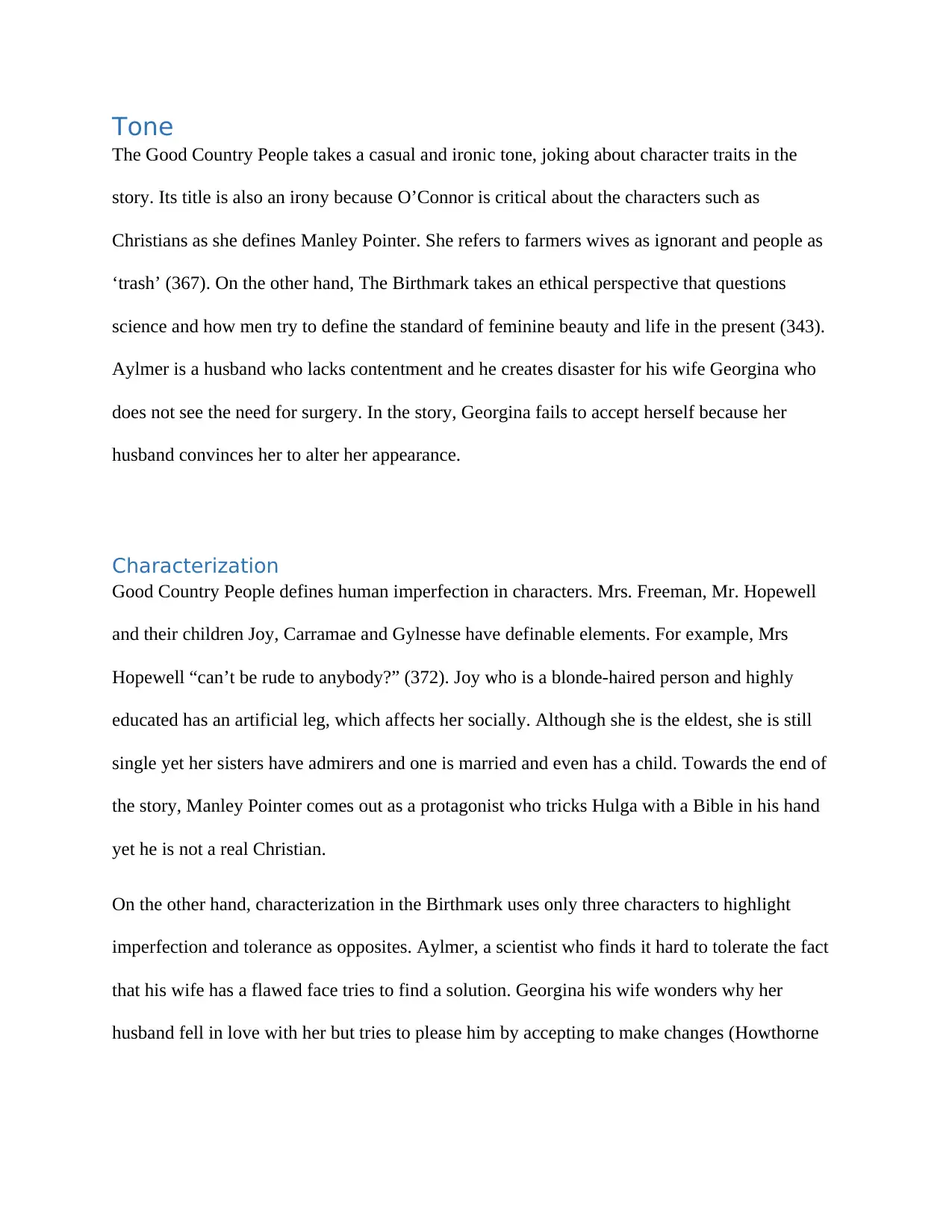
Tone
The Good Country People takes a casual and ironic tone, joking about character traits in the
story. Its title is also an irony because O’Connor is critical about the characters such as
Christians as she defines Manley Pointer. She refers to farmers wives as ignorant and people as
‘trash’ (367). On the other hand, The Birthmark takes an ethical perspective that questions
science and how men try to define the standard of feminine beauty and life in the present (343).
Aylmer is a husband who lacks contentment and he creates disaster for his wife Georgina who
does not see the need for surgery. In the story, Georgina fails to accept herself because her
husband convinces her to alter her appearance.
Characterization
Good Country People defines human imperfection in characters. Mrs. Freeman, Mr. Hopewell
and their children Joy, Carramae and Gylnesse have definable elements. For example, Mrs
Hopewell “can’t be rude to anybody?” (372). Joy who is a blonde-haired person and highly
educated has an artificial leg, which affects her socially. Although she is the eldest, she is still
single yet her sisters have admirers and one is married and even has a child. Towards the end of
the story, Manley Pointer comes out as a protagonist who tricks Hulga with a Bible in his hand
yet he is not a real Christian.
On the other hand, characterization in the Birthmark uses only three characters to highlight
imperfection and tolerance as opposites. Aylmer, a scientist who finds it hard to tolerate the fact
that his wife has a flawed face tries to find a solution. Georgina his wife wonders why her
husband fell in love with her but tries to please him by accepting to make changes (Howthorne
The Good Country People takes a casual and ironic tone, joking about character traits in the
story. Its title is also an irony because O’Connor is critical about the characters such as
Christians as she defines Manley Pointer. She refers to farmers wives as ignorant and people as
‘trash’ (367). On the other hand, The Birthmark takes an ethical perspective that questions
science and how men try to define the standard of feminine beauty and life in the present (343).
Aylmer is a husband who lacks contentment and he creates disaster for his wife Georgina who
does not see the need for surgery. In the story, Georgina fails to accept herself because her
husband convinces her to alter her appearance.
Characterization
Good Country People defines human imperfection in characters. Mrs. Freeman, Mr. Hopewell
and their children Joy, Carramae and Gylnesse have definable elements. For example, Mrs
Hopewell “can’t be rude to anybody?” (372). Joy who is a blonde-haired person and highly
educated has an artificial leg, which affects her socially. Although she is the eldest, she is still
single yet her sisters have admirers and one is married and even has a child. Towards the end of
the story, Manley Pointer comes out as a protagonist who tricks Hulga with a Bible in his hand
yet he is not a real Christian.
On the other hand, characterization in the Birthmark uses only three characters to highlight
imperfection and tolerance as opposites. Aylmer, a scientist who finds it hard to tolerate the fact
that his wife has a flawed face tries to find a solution. Georgina his wife wonders why her
husband fell in love with her but tries to please him by accepting to make changes (Howthorne
Paraphrase This Document
Need a fresh take? Get an instant paraphrase of this document with our AI Paraphraser
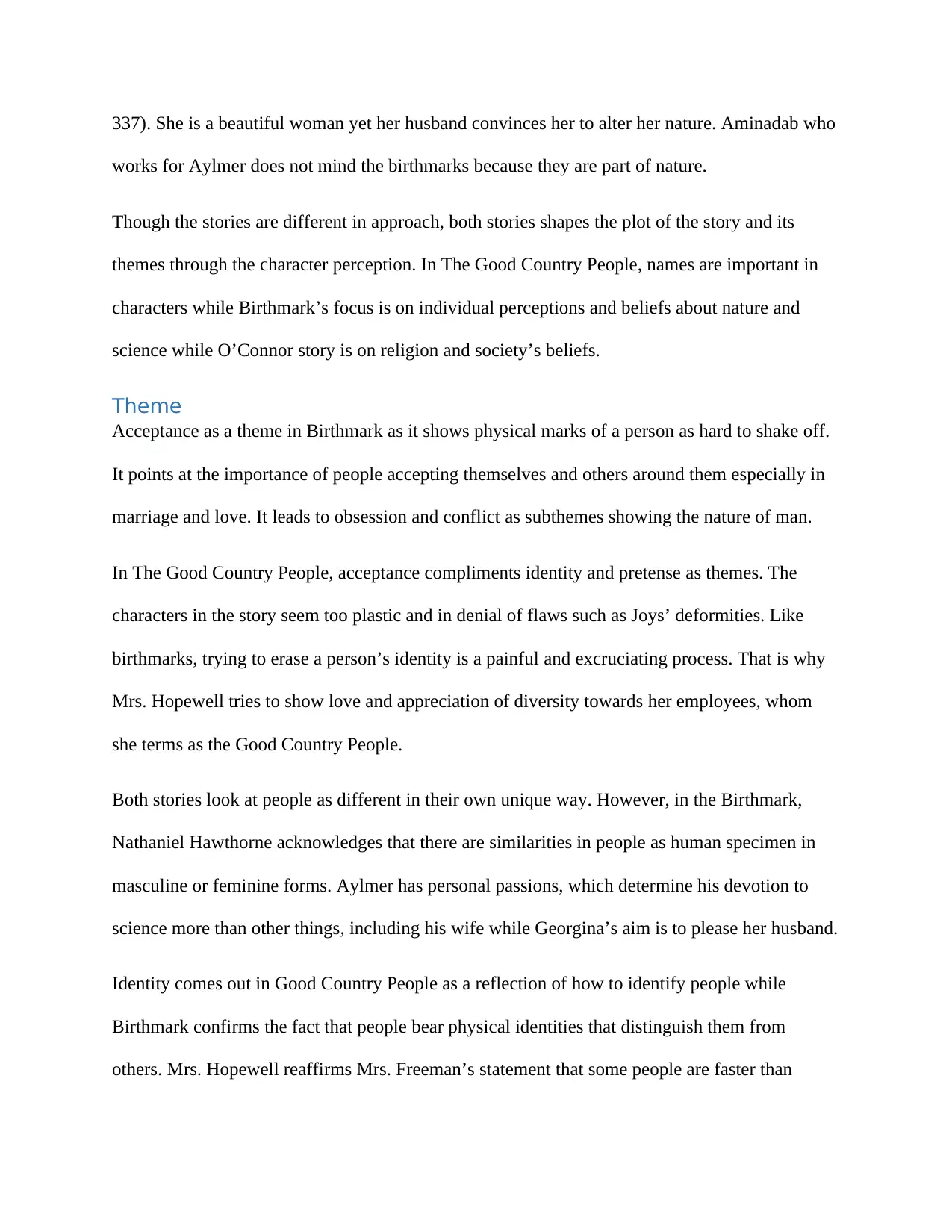
337). She is a beautiful woman yet her husband convinces her to alter her nature. Aminadab who
works for Aylmer does not mind the birthmarks because they are part of nature.
Though the stories are different in approach, both stories shapes the plot of the story and its
themes through the character perception. In The Good Country People, names are important in
characters while Birthmark’s focus is on individual perceptions and beliefs about nature and
science while O’Connor story is on religion and society’s beliefs.
Theme
Acceptance as a theme in Birthmark as it shows physical marks of a person as hard to shake off.
It points at the importance of people accepting themselves and others around them especially in
marriage and love. It leads to obsession and conflict as subthemes showing the nature of man.
In The Good Country People, acceptance compliments identity and pretense as themes. The
characters in the story seem too plastic and in denial of flaws such as Joys’ deformities. Like
birthmarks, trying to erase a person’s identity is a painful and excruciating process. That is why
Mrs. Hopewell tries to show love and appreciation of diversity towards her employees, whom
she terms as the Good Country People.
Both stories look at people as different in their own unique way. However, in the Birthmark,
Nathaniel Hawthorne acknowledges that there are similarities in people as human specimen in
masculine or feminine forms. Aylmer has personal passions, which determine his devotion to
science more than other things, including his wife while Georgina’s aim is to please her husband.
Identity comes out in Good Country People as a reflection of how to identify people while
Birthmark confirms the fact that people bear physical identities that distinguish them from
others. Mrs. Hopewell reaffirms Mrs. Freeman’s statement that some people are faster than
works for Aylmer does not mind the birthmarks because they are part of nature.
Though the stories are different in approach, both stories shapes the plot of the story and its
themes through the character perception. In The Good Country People, names are important in
characters while Birthmark’s focus is on individual perceptions and beliefs about nature and
science while O’Connor story is on religion and society’s beliefs.
Theme
Acceptance as a theme in Birthmark as it shows physical marks of a person as hard to shake off.
It points at the importance of people accepting themselves and others around them especially in
marriage and love. It leads to obsession and conflict as subthemes showing the nature of man.
In The Good Country People, acceptance compliments identity and pretense as themes. The
characters in the story seem too plastic and in denial of flaws such as Joys’ deformities. Like
birthmarks, trying to erase a person’s identity is a painful and excruciating process. That is why
Mrs. Hopewell tries to show love and appreciation of diversity towards her employees, whom
she terms as the Good Country People.
Both stories look at people as different in their own unique way. However, in the Birthmark,
Nathaniel Hawthorne acknowledges that there are similarities in people as human specimen in
masculine or feminine forms. Aylmer has personal passions, which determine his devotion to
science more than other things, including his wife while Georgina’s aim is to please her husband.
Identity comes out in Good Country People as a reflection of how to identify people while
Birthmark confirms the fact that people bear physical identities that distinguish them from
others. Mrs. Hopewell reaffirms Mrs. Freeman’s statement that some people are faster than
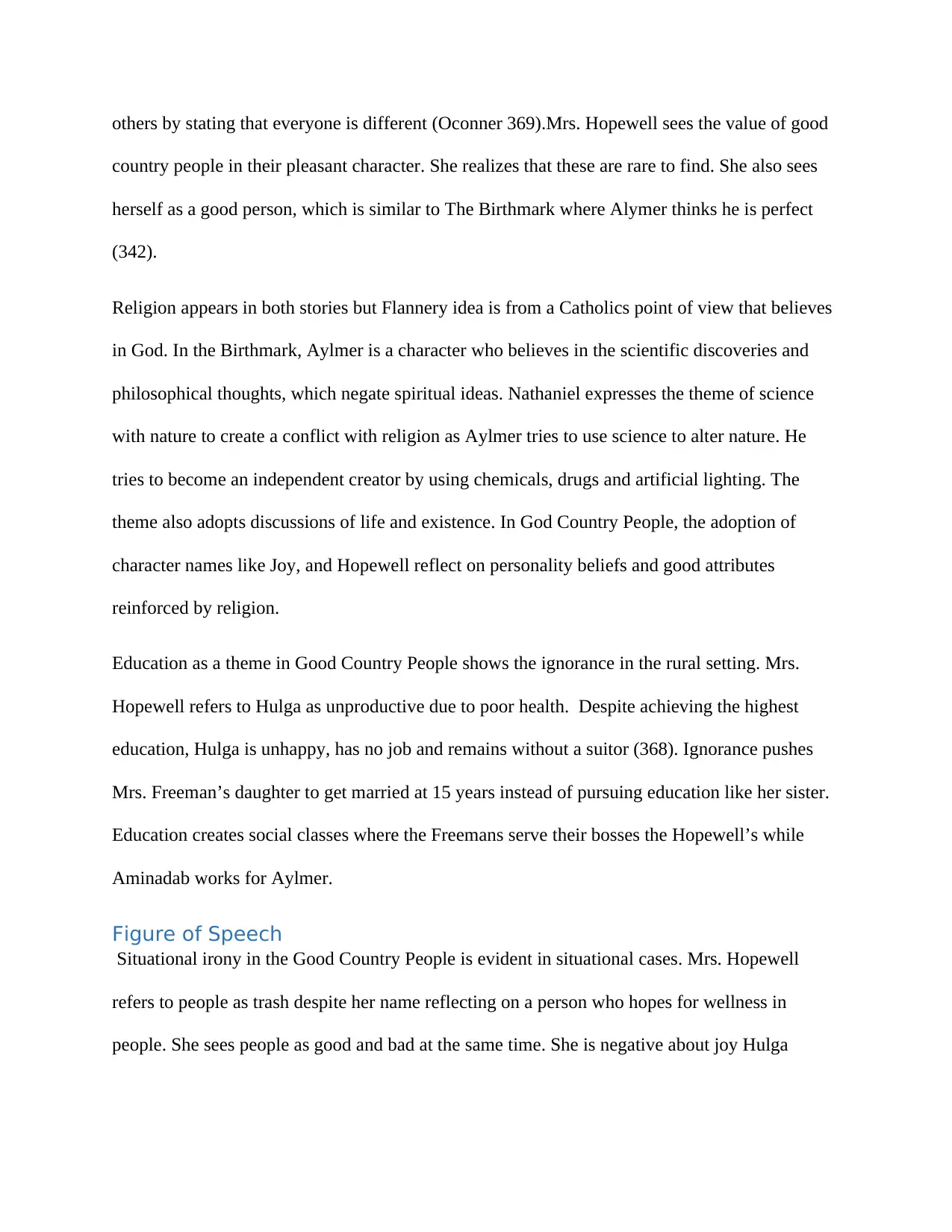
others by stating that everyone is different (Oconner 369).Mrs. Hopewell sees the value of good
country people in their pleasant character. She realizes that these are rare to find. She also sees
herself as a good person, which is similar to The Birthmark where Alymer thinks he is perfect
(342).
Religion appears in both stories but Flannery idea is from a Catholics point of view that believes
in God. In the Birthmark, Aylmer is a character who believes in the scientific discoveries and
philosophical thoughts, which negate spiritual ideas. Nathaniel expresses the theme of science
with nature to create a conflict with religion as Aylmer tries to use science to alter nature. He
tries to become an independent creator by using chemicals, drugs and artificial lighting. The
theme also adopts discussions of life and existence. In God Country People, the adoption of
character names like Joy, and Hopewell reflect on personality beliefs and good attributes
reinforced by religion.
Education as a theme in Good Country People shows the ignorance in the rural setting. Mrs.
Hopewell refers to Hulga as unproductive due to poor health. Despite achieving the highest
education, Hulga is unhappy, has no job and remains without a suitor (368). Ignorance pushes
Mrs. Freeman’s daughter to get married at 15 years instead of pursuing education like her sister.
Education creates social classes where the Freemans serve their bosses the Hopewell’s while
Aminadab works for Aylmer.
Figure of Speech
Situational irony in the Good Country People is evident in situational cases. Mrs. Hopewell
refers to people as trash despite her name reflecting on a person who hopes for wellness in
people. She sees people as good and bad at the same time. She is negative about joy Hulga
country people in their pleasant character. She realizes that these are rare to find. She also sees
herself as a good person, which is similar to The Birthmark where Alymer thinks he is perfect
(342).
Religion appears in both stories but Flannery idea is from a Catholics point of view that believes
in God. In the Birthmark, Aylmer is a character who believes in the scientific discoveries and
philosophical thoughts, which negate spiritual ideas. Nathaniel expresses the theme of science
with nature to create a conflict with religion as Aylmer tries to use science to alter nature. He
tries to become an independent creator by using chemicals, drugs and artificial lighting. The
theme also adopts discussions of life and existence. In God Country People, the adoption of
character names like Joy, and Hopewell reflect on personality beliefs and good attributes
reinforced by religion.
Education as a theme in Good Country People shows the ignorance in the rural setting. Mrs.
Hopewell refers to Hulga as unproductive due to poor health. Despite achieving the highest
education, Hulga is unhappy, has no job and remains without a suitor (368). Ignorance pushes
Mrs. Freeman’s daughter to get married at 15 years instead of pursuing education like her sister.
Education creates social classes where the Freemans serve their bosses the Hopewell’s while
Aminadab works for Aylmer.
Figure of Speech
Situational irony in the Good Country People is evident in situational cases. Mrs. Hopewell
refers to people as trash despite her name reflecting on a person who hopes for wellness in
people. She sees people as good and bad at the same time. She is negative about joy Hulga
⊘ This is a preview!⊘
Do you want full access?
Subscribe today to unlock all pages.

Trusted by 1+ million students worldwide
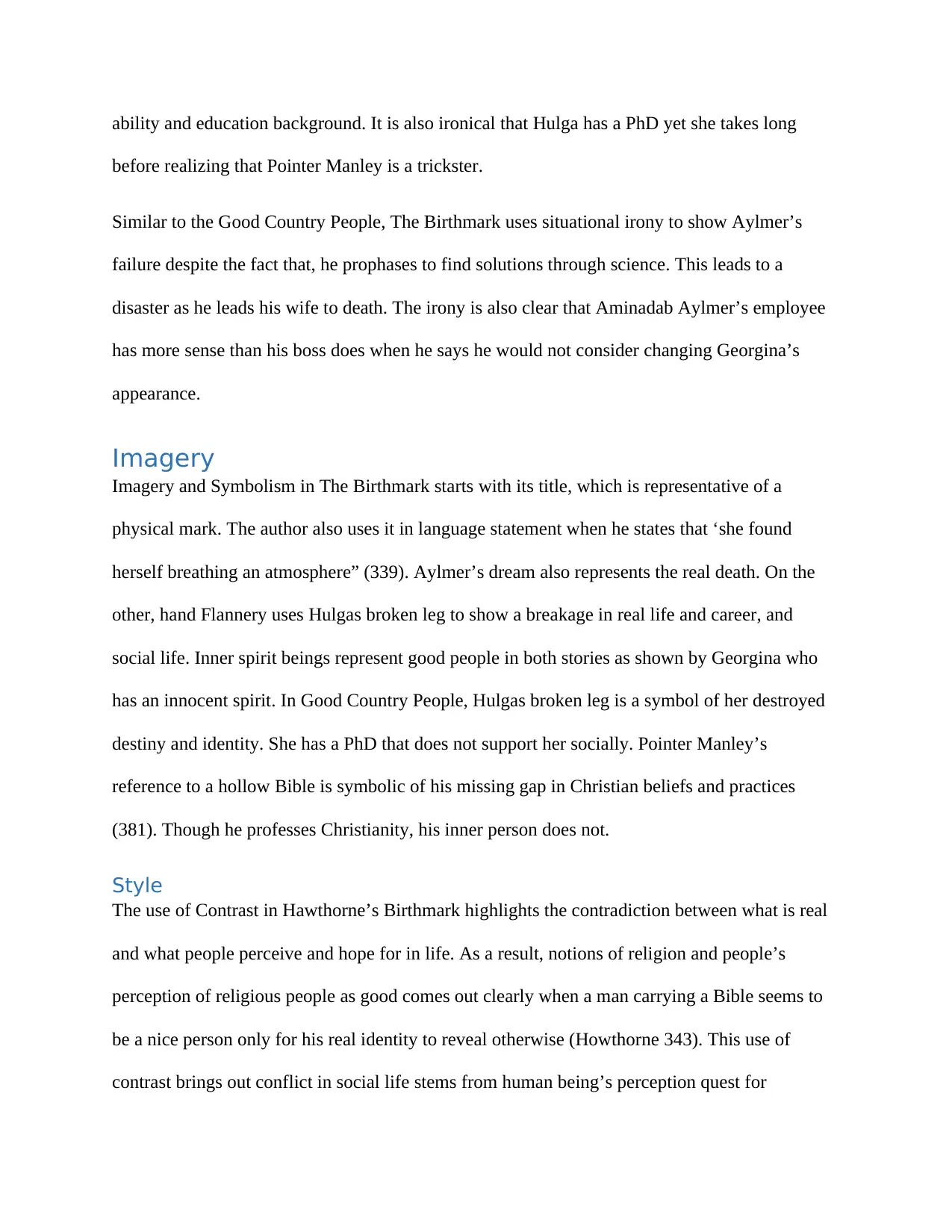
ability and education background. It is also ironical that Hulga has a PhD yet she takes long
before realizing that Pointer Manley is a trickster.
Similar to the Good Country People, The Birthmark uses situational irony to show Aylmer’s
failure despite the fact that, he prophases to find solutions through science. This leads to a
disaster as he leads his wife to death. The irony is also clear that Aminadab Aylmer’s employee
has more sense than his boss does when he says he would not consider changing Georgina’s
appearance.
Imagery
Imagery and Symbolism in The Birthmark starts with its title, which is representative of a
physical mark. The author also uses it in language statement when he states that ‘she found
herself breathing an atmosphere” (339). Aylmer’s dream also represents the real death. On the
other, hand Flannery uses Hulgas broken leg to show a breakage in real life and career, and
social life. Inner spirit beings represent good people in both stories as shown by Georgina who
has an innocent spirit. In Good Country People, Hulgas broken leg is a symbol of her destroyed
destiny and identity. She has a PhD that does not support her socially. Pointer Manley’s
reference to a hollow Bible is symbolic of his missing gap in Christian beliefs and practices
(381). Though he professes Christianity, his inner person does not.
Style
The use of Contrast in Hawthorne’s Birthmark highlights the contradiction between what is real
and what people perceive and hope for in life. As a result, notions of religion and people’s
perception of religious people as good comes out clearly when a man carrying a Bible seems to
be a nice person only for his real identity to reveal otherwise (Howthorne 343). This use of
contrast brings out conflict in social life stems from human being’s perception quest for
before realizing that Pointer Manley is a trickster.
Similar to the Good Country People, The Birthmark uses situational irony to show Aylmer’s
failure despite the fact that, he prophases to find solutions through science. This leads to a
disaster as he leads his wife to death. The irony is also clear that Aminadab Aylmer’s employee
has more sense than his boss does when he says he would not consider changing Georgina’s
appearance.
Imagery
Imagery and Symbolism in The Birthmark starts with its title, which is representative of a
physical mark. The author also uses it in language statement when he states that ‘she found
herself breathing an atmosphere” (339). Aylmer’s dream also represents the real death. On the
other, hand Flannery uses Hulgas broken leg to show a breakage in real life and career, and
social life. Inner spirit beings represent good people in both stories as shown by Georgina who
has an innocent spirit. In Good Country People, Hulgas broken leg is a symbol of her destroyed
destiny and identity. She has a PhD that does not support her socially. Pointer Manley’s
reference to a hollow Bible is symbolic of his missing gap in Christian beliefs and practices
(381). Though he professes Christianity, his inner person does not.
Style
The use of Contrast in Hawthorne’s Birthmark highlights the contradiction between what is real
and what people perceive and hope for in life. As a result, notions of religion and people’s
perception of religious people as good comes out clearly when a man carrying a Bible seems to
be a nice person only for his real identity to reveal otherwise (Howthorne 343). This use of
contrast brings out conflict in social life stems from human being’s perception quest for
Paraphrase This Document
Need a fresh take? Get an instant paraphrase of this document with our AI Paraphraser
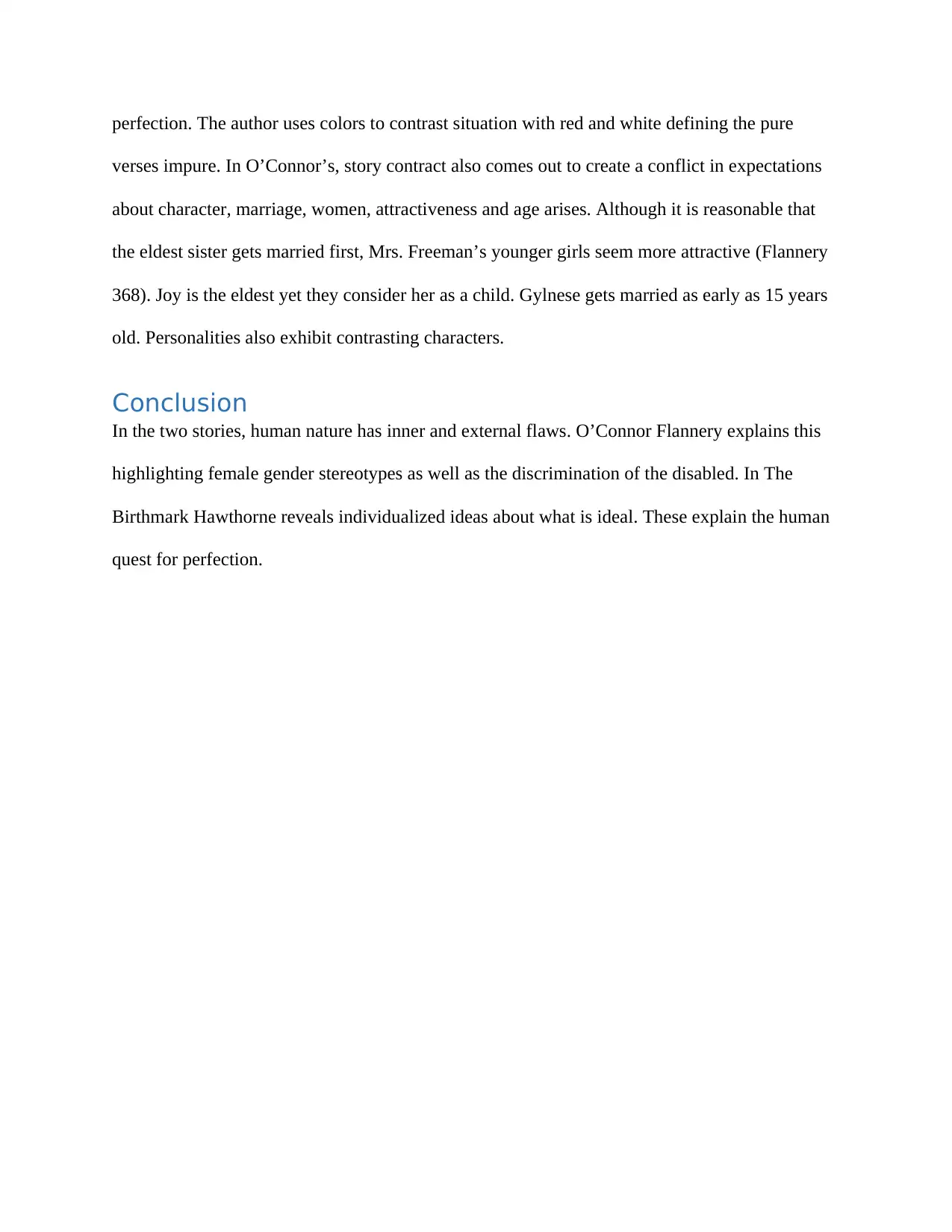
perfection. The author uses colors to contrast situation with red and white defining the pure
verses impure. In O’Connor’s, story contract also comes out to create a conflict in expectations
about character, marriage, women, attractiveness and age arises. Although it is reasonable that
the eldest sister gets married first, Mrs. Freeman’s younger girls seem more attractive (Flannery
368). Joy is the eldest yet they consider her as a child. Gylnese gets married as early as 15 years
old. Personalities also exhibit contrasting characters.
Conclusion
In the two stories, human nature has inner and external flaws. O’Connor Flannery explains this
highlighting female gender stereotypes as well as the discrimination of the disabled. In The
Birthmark Hawthorne reveals individualized ideas about what is ideal. These explain the human
quest for perfection.
verses impure. In O’Connor’s, story contract also comes out to create a conflict in expectations
about character, marriage, women, attractiveness and age arises. Although it is reasonable that
the eldest sister gets married first, Mrs. Freeman’s younger girls seem more attractive (Flannery
368). Joy is the eldest yet they consider her as a child. Gylnese gets married as early as 15 years
old. Personalities also exhibit contrasting characters.
Conclusion
In the two stories, human nature has inner and external flaws. O’Connor Flannery explains this
highlighting female gender stereotypes as well as the discrimination of the disabled. In The
Birthmark Hawthorne reveals individualized ideas about what is ideal. These explain the human
quest for perfection.
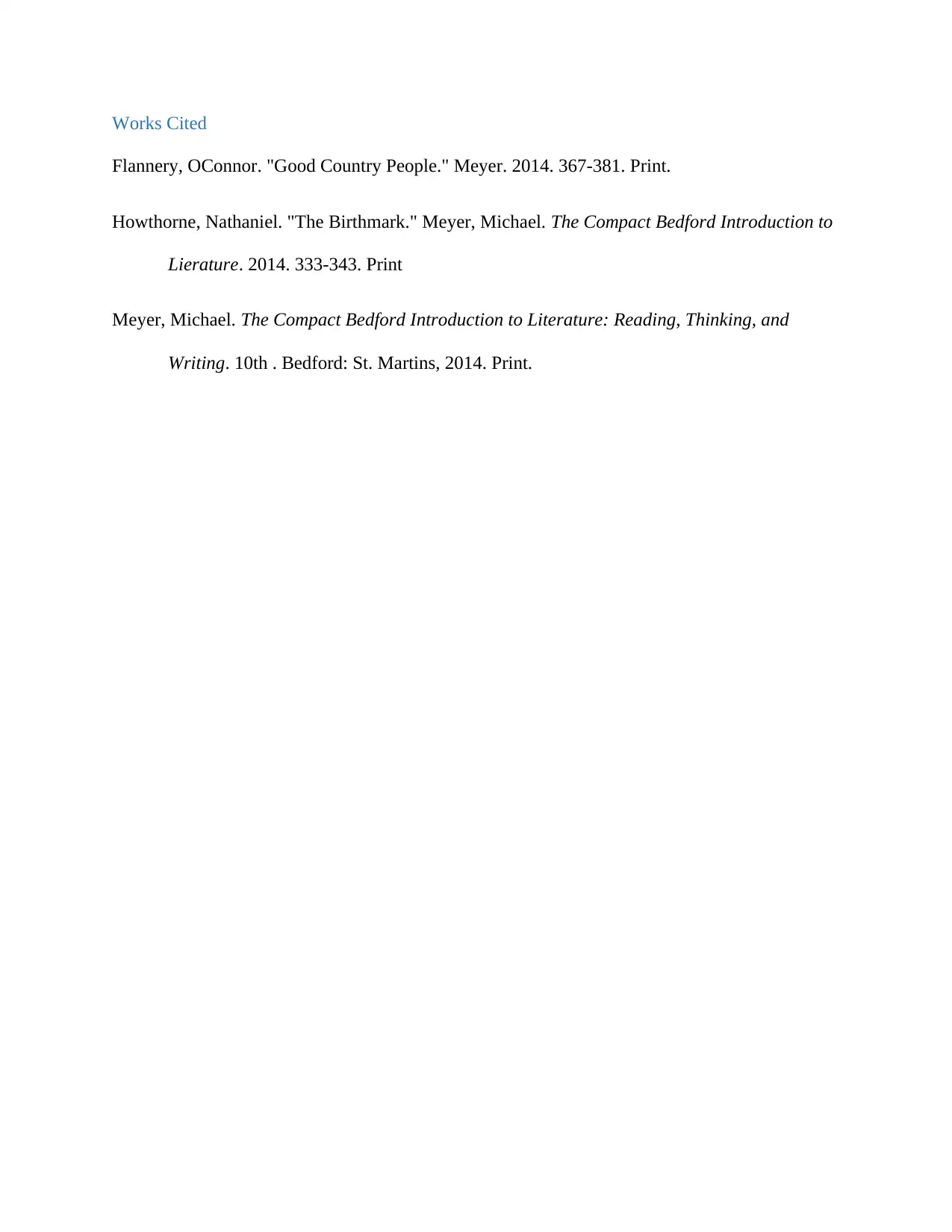
Works Cited
Flannery, OConnor. "Good Country People." Meyer. 2014. 367-381. Print.
Howthorne, Nathaniel. "The Birthmark." Meyer, Michael. The Compact Bedford Introduction to
Lierature. 2014. 333-343. Print
Meyer, Michael. The Compact Bedford Introduction to Literature: Reading, Thinking, and
Writing. 10th . Bedford: St. Martins, 2014. Print.
Flannery, OConnor. "Good Country People." Meyer. 2014. 367-381. Print.
Howthorne, Nathaniel. "The Birthmark." Meyer, Michael. The Compact Bedford Introduction to
Lierature. 2014. 333-343. Print
Meyer, Michael. The Compact Bedford Introduction to Literature: Reading, Thinking, and
Writing. 10th . Bedford: St. Martins, 2014. Print.
⊘ This is a preview!⊘
Do you want full access?
Subscribe today to unlock all pages.

Trusted by 1+ million students worldwide
1 out of 9
Your All-in-One AI-Powered Toolkit for Academic Success.
+13062052269
info@desklib.com
Available 24*7 on WhatsApp / Email
![[object Object]](/_next/static/media/star-bottom.7253800d.svg)
Unlock your academic potential
Copyright © 2020–2025 A2Z Services. All Rights Reserved. Developed and managed by ZUCOL.